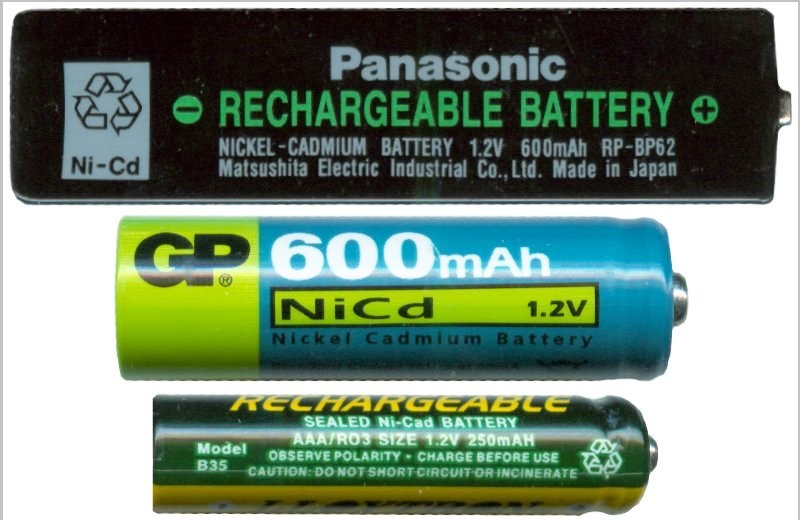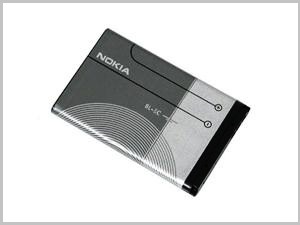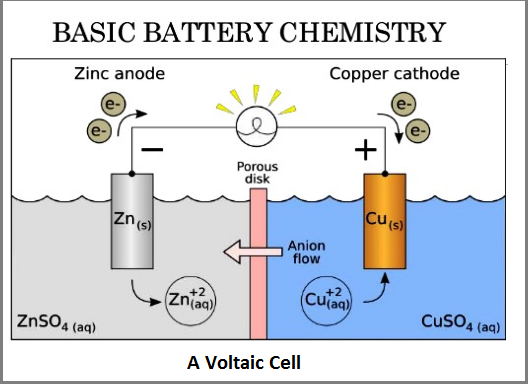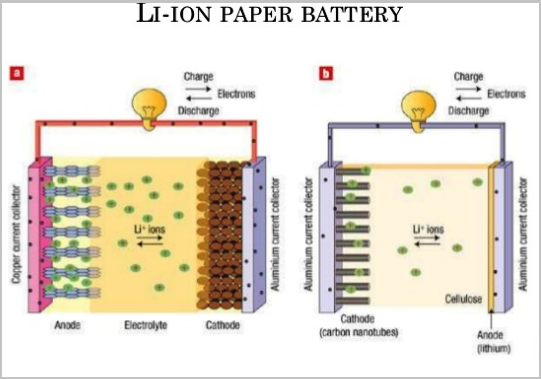Paper Battery
Introduction
A paper battery is an electric battery which was engineered to use a spacer formed largely of cellulose -the major constituent of paper. This helps to incorporates nano-scale structures to act as high surface-area electrodes to perk up conductivity.
In addition to being unusually thin, paper batteries are more flexible and environmentally-friendly compared to other batteries. These batteries allow integration into a wide range of products; and their functioning is similar to conventional chemical batteries with an significant difference that they are non-corrosive and do not require widespread housing.
Principle
- This battery produces electricity in the same way as the conventional lithium-ion batteries, but all the components that have been incorporated into are lightweight, flexible sheet of paper.
- These devices are formed by combining cellulose with an infusion of aligned carbon nanotubes.
- The electrolyte and the ions that carry the charge can be varied depending the use of the battery.
- A conventional Li-ion battery can be incorporated in cellulose-nanotube composite as shown in the blow image.
History
The creation of the Paper Battery drew from a diverse pool of disciplines, and these batteries require expertise in materials science, energy storage, and chemistry. However, in August 2007, a research team at Rensselear Polytechnic Institute Led by Drs. Robert Linhardt, John H. Broadbent, Pulickel M. Ajayan, Omkaram Nalamasu with a joint meeting in Material Science and engineering developed the Paper Battery, which is also known as Nano Composite Paper. In December 2009,Yi Cui and his team at Stanford University successfully made an actual prototype that gave a terminal voltage of 1.5 V.
NICD Battery

- NICD rechargeable battery using nickel oxide hydroxide and metallic Cadmium as electrodes.
- Terminal voltage of 1.2V.
- It is rigged, high specific power (150W/kg), this battery life will be long and light.
- This battery is used in UPS, portable power tools, flashlights, photography equipment, emergency lighting, and portable electronic devices.
- However disadvantages include Memory effect, Environmental hazards, and cost.
LI-ION Battery

- This battery is constructed using graphite rod, Lithium cobalt oxide(or Lithium manganese oxide) as electrodes and lithium hexafluorophosphate (LiPF6) as electrodes.
- Has Terminal voltage of 1.2V
- Rugged and high specific power (150W/kg), with log life, and light.
- Used in UPS, portable power tools, Photography equipment, flashlights, portable electronic devices, and emergency lighting.
- While the disadvantages include Environmental hazards, cost and Memory effect.
Issues with Conventional Batteries:
- Low specific power compared to fuels
- High charging Time
- Weight and size
- Explosion, corrosion, leakage
- Environmental hazards
- High Cost
- Terminal voltage constraints
li-ion Paper Battery
While the nanotubes, which colour the paper black, will act as electrodes and allow the storage devices to conduct electricity. The device functions as both a lithium-ion battery and a super-capacitor, which stores charge like a battery. But it has no liquid electrolyte. However the paper battery provides a long, steady power output as against a conventional battery burst of high energy. The ionic liquid electrolyte that is soaked into the paper is a liquid salt and contains no water, so it won't freeze or boil. However, the researcher are going around the world to replace this ionic electrolyte with body fluids, sweat, blood, etc.
Fabrication
The materials required for the preparation of paper battery are:
- Copier paper and Carbon nano inkCarbon of nano rods, surface adhesive agent and ionic salt solutions. Whereas Carbon nano ink is spread on one side of the paper.
- However, the paper is kept in the oven at 150 degree Celsius. This evaporates the water content on the paper. The battery is then ready and would provide a terminal voltage enough to power an LED.
Advantages
- Light, rugged, flexible, van be be rolled crunched, cut, made into any shape.
- The nano composite paper is compatible with a number of electrolyte, like urine, blood, sweat, etc.
- If we stack 500 sheets together in a ream, that's 500 times the voltage. If we rip the paper in half then we cut power
- by 50%. so we can control the power and voltage issue
- Non - toxic and hence can be used to power pacemakers and RF tags
- It is very useful where burst of energy is required for operation like mostly electric vehicles.
- The electrolyte contains no water, thus there's nothing in the batteries to freeze or evaporate, potentially allowing operation in extreme temperatures.
- It is environment friendly.
- Paper Battery would be the answer to the electrical Energy storage Problems.
However, the composition of these batteries is what sets them apart from traditional batteries. We all know that paper is abundant and self-sustaining, which makes paper cheap. Though disposing the paper is not an inexpensive task since paper is combustible as well as biodegradable. But, using paper gives the battery a great degree of flexibility. The battery can be bent or wrapped around objects instead of requiring a fixed casing. Also, being a thin, flat sheet, the paper battery can simply fit into tight places, reducing the size and weight of the device it powers. While the use of paper increases the electron flow which is well suited for high performance applications. The paper used in paper batteries can be an supplement to improve its performance characteristics.
Patterning techniques such as photolithography, wax printing, and laser micromachining are used to create hydrophobic and hydrophilic sections on the paper to make a pathway to direct the capillary action of the fluids used in batteries. Similar techniques can be used to create electrical pathways on paper to create paper electrical devices and can integrate paper energy storage.
Limitations
At present, the devices are only a few inches across and they have to be scaled up to sheets of newspaper size to make it commercially viable. Carbon nanotubes are expensive .However, the idea is still in the labs and a commercially viable paper battery will take at least 40- 70 years to come into reality. While the researchers in nanotechnology to mass produce nanotubes is promising.
Applications
- Pace makers (uses blood and electrolyte)
- Devices in space Shuttles
- Used as alternate to conventional batteries in gadgets.
- Powered smart cards RF id tags, smart clothes.
- Disposable medical devices - like Single use delivery and diagnostic devices could have Power Paper incorporated into their construction to allow for sensors and smart labels.
- Paper battery is set in iontophoresis patch. It helps to deliver functional drugs, local anesthesia, anodyne, antichloristic, etc into the skin.
- Paper battery could one day power motor vehicles and aircrafts and replace the conventional fossil fuel based engines with electric motors.
Conclusion
However, the possible applications for paper batteries derives from their important advantages as compared to conventional battery technologies. These can be made in virtually any shape and size to meet the requirements of each application. while the batteries are rechargeable and have reduced cost and weight less which in itself may give birth to new applications. Paper battery could solve all the problems associated with electrical energy storage. However, the reality is still very far away, though the researches are promising.









